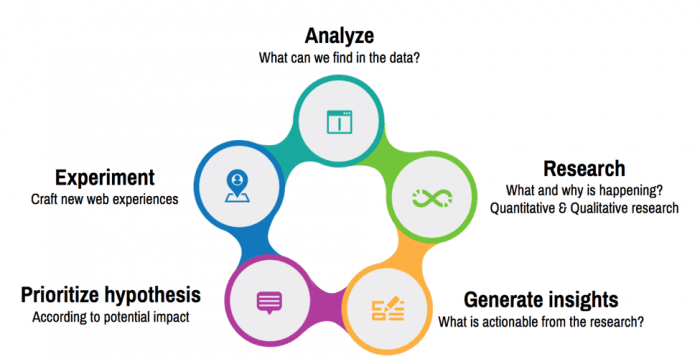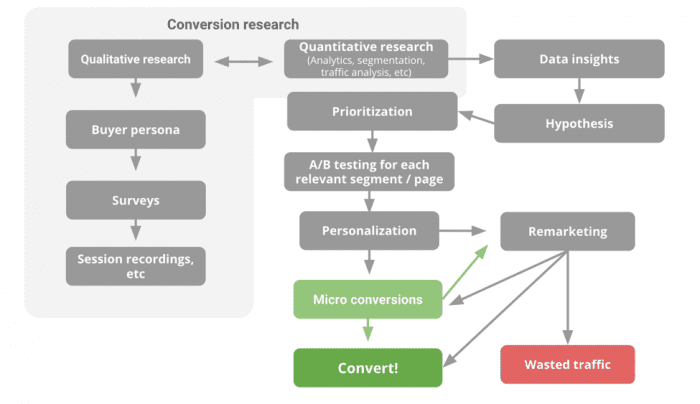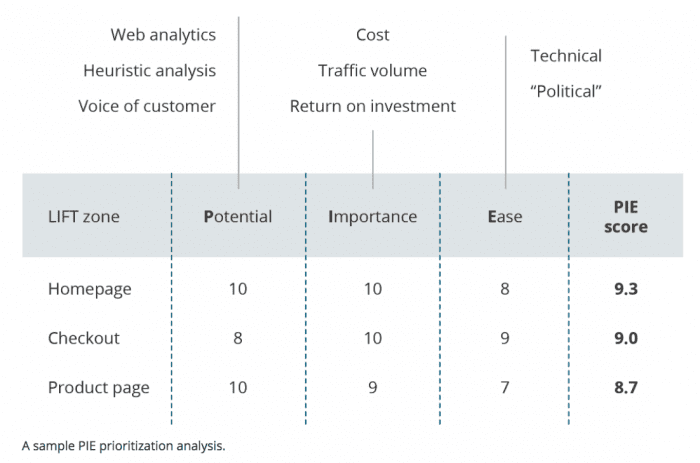Conversion rate optimization (CRO) has generated a lot of hype and it is seen as a silver bullet that will solve all the problems the ecommerce business has.
The truth is there are two sides of the same coin. The first one is that CRO is indeed as magical as the compound interest: only a 6% add of incremental increase will lead to 90% more conversions in just 12 months. This means you double your conversions and you decrease the customer acquisition cost - double strike! This is the good side of conversion optimization.
On the other hand, the bad side of CRO is that not all companies are qualified to start the optimization process, and not all the companies that adopted this technique are doing it in the right way.
Further on, in this article, I want to present you the real path of conversion rate optimization, from start to success.

Before we go on and tackle about the phases of CRO, you must understand that this is a process, not just a checkbox to tick. The framework that almost all companies use is the same from the design thinking. You identify the problem, create a strategy, implement the experiment, analyze the impact and implement the winner.
1. Business research
First, let’s focus on the business research, and there are specific questions here that will lead to outstanding answers. In this phase, whether you are working in a company or digital agency, ask the following questions:
- What does a conversion mean for our type of business? - it can be a transaction, a lead, etc.
- Which micro-conversions can move the needle?
- Have you done optimization before? (in the happy case this happened) - it is crucial to discover what we have to learn from previous experiments and which are the outcomes that we have got in the past.
- What is the level of freedom that we have in order to do conversion optimization: on how many visitors can we do CRO?
Using this information, we can come up with a mathematical model to identify the real impact of conversion rate optimization. Not all the websites have enough traffic to start testing. Try out this CRO calculator, play with the numbers to scale your business and you will see for yourself that improving conversion is better than acquiring new traffic. It’s time you use intelligent data to make better business decisions.
Based on the maturity level of the company, conversion rate optimization can be considered just a nice thing to have or a vital process to keep it alive.
Once you have the answers to all these questions and you have the numbers that show you the need to focus on CRO, the next step is to know your buyer persona, the real data, and factors that generate growth.

2. Qualitative research
When it comes to the eCommerce buyer persona, discover information such as demographics, psychological factors that determine his behavior and the emotions that stand behind his action. There are two main categories that arise based on the emotion type: good and, let’s say, bad emotions.
People are buying products because they want to overcome a certain fear and pain, or because they want to fulfill a desire and make a dream come true. This is why you should identify the purchase intention, the barriers they have, what drives them to convert and what stops them to buy from your website.
In this precise moment of the research, you can do qualitative research to understand your buyer persona, know their cart abandonment reasons and the Net Promoter Score for various types of customers. If you are using the RFM type of segmentation, identify the NPS for gold, silver and bronze customers and provide them the right incentive, at the right time. We use it all the time at Omniconvert.
3. Quantitative research
Before even starting to dive into the quantitative data, I want to remind you the importance of data hygiene. Correctly collecting data is vital. So, check if your Google Analytics is set up right and you track the right goals. You can use this free tool to discover new insights about your business based on your Google Analytics account.
As part of the quantitative research, the RFM segmentation is very useful because it allows you to categorize users based on how recent their last order was (recency), how often do they buy from you (frequency) and how much money do they spend on your eCommerce website (monetary value). Use this precious information later on when you plan a strategy to improve the retention rate and implement experiments according to every vital customer segment.
Another action that can be a part of the qualitative research is to analyze the transcripts of the support chat and calls. This might point out some issues that customers have had and you can come up with the proper solution. You can’t take any pills before knowing the right diagnosis.
Considering all the elements above, ask yourself these questions:
- Am I understanding my customers according to their needs and emotions?
- Am I communicating the UVP that fulfills and solves my customer’s problems?
How can you find out the answers to this problems?
By asking your customers directly using surveys. Gathering qualitative data with on-site surveys is the pillar and the beginning of any conversion rate optimization process. Of course, qualitative data has to be backed by quantitative data to give you the whole picture of where you should start.
Before ending the research phase, you should know who your buyer persona is, purchasing barriers, RFM segments, and your most precious customers.
4. Craft the strategy
Using the results of the research, plan your strategy. Create a list of all the insights you have, assess the business impact and the time to impact, and then prioritize. While prioritizing the hypothesis for further experiments, use a framework that makes it clear for you on which experiments to focus. For example, we are using the PIE system from Widerfunnel and it works very well:

To sum up, before starting to experiment, make sure that you understand the pain of your customers and their behavior. It is crucial to take a look at the hidden gems from your Google Analytics and understand from a UX perspective which are the blockers for your audience.
CRO is a long-term process: you can’t lose weight if you go to the gym only once a month. It’s a matter of habit and on-going activities.
May all your conversion optimization efforts be successful and don’t forget the main part: sometimes you win, sometimes you learn!

Thanks to Valentin Radu for sharing their advice and opinion in this post. Valentin is a serial entrepreneur and visionary involved in tech and digital marketing for the past 12 years. He is the founder of
Omniconvert, a growth enabler tool for mid-size eCommerce websites looking to become customer-centric. Omniconvert is a conversion rate optimization platform that combines the power of AB testing, web personalization, web surveys using an advanced segmentation engine. Valentin is known for his unyielding positive energy, creativity, and knowledge about marketing and business. He is also an international keynote speaker. Most of the times he talks at conferences about eCommerce, optimization, and growth. You can follow him/ her on
Twitter or connect on
LinkedIn.






 Thanks to Valentin Radu for sharing their advice and opinion in this post. Valentin is a serial entrepreneur and visionary involved in tech and digital marketing for the past 12 years. He is the founder of
Thanks to Valentin Radu for sharing their advice and opinion in this post. Valentin is a serial entrepreneur and visionary involved in tech and digital marketing for the past 12 years. He is the founder of 


